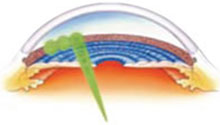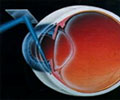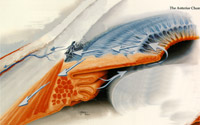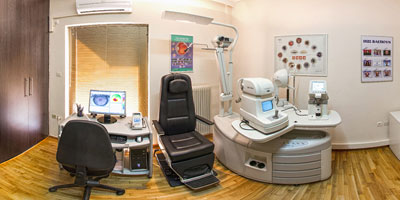SLT The new laser treatment for glaucoma
 What is SLT?
What is SLT?
SLT comes from the initials Selective Laser Trabeculoplasty. SLT is a simple, effective laser procedure that reduces the intraocular pressure associated with glaucoma and ocular hypertension. It is performed in the doctor’s surgery or in the ophthalmological centre and does not take more than five minutes.
How does the laser work?
SLT uses low-energy pulses of light aimed at the melanin or pigment found in specific cells in the affected eye. In response, the body’s healing mechanisms work to regenerate these cells. This procedure improves the drainage of the eye, thus reducing the pressure. Adjacent cells and other eye tissues are not damaged.
Does SLT hurt?
No, it does not hurt and there are no side effects to worry about.
 What happens during the laser procedure?
What happens during the laser procedure?
Prior to treatment, eye drops are administered to prepare the eye and to give a light anesthesia. The light pulses are then transmitted through a special microscope and a special lens in contact with the eye. The whole process takes a few minutes. One to three days later, the pressure is expected to drop by about 30%. Of course, your doctor will need to check the pressure at regular intervals.
How often can I do SLT?
The SLT is a soft, non-thermal and non-invasive laser that allows the process to be repeated, if necessary. The treatment can be repeated as long as the laser is effective.
Who is eligible for the SLT?
The following categories of patients may be eligible for treatment.
- If there is ocular hypertension, open-angle glaucoma, pseudoexfoliation or pigmented glaucoma (ask your ophthalmologist)
- If you are allergic to anti-glaucoma drugs or have difficulty taking them
- If you are taking anti-glaucoma eye drops and you either want to stop them or combine them with SLT for better results.
- If you have had previous laser treatment that was ineffective (ALT: argon laser trabeculoplasty)
What if SLT does not work in my case?
SLT reduces intraocular pressure by an average of 25-30% in 75-85% of patients receiving treatment. For those who do not respond to treatment, other treatments such as medication or surgery may be more effective.
 Why is it important to reduce intraocular pressure?
Why is it important to reduce intraocular pressure?
The aqueous humour of the eye is constantly produced and drained to maintain a healthy balance between the cornea and the lens of the eye. If the drainage decreases, the intraocular pressure increases and then glaucoma (damage to the optic nerve and visual field that threatens vision) can occur. The very purpose of reducing intraocular pressure is to maintain vision.

